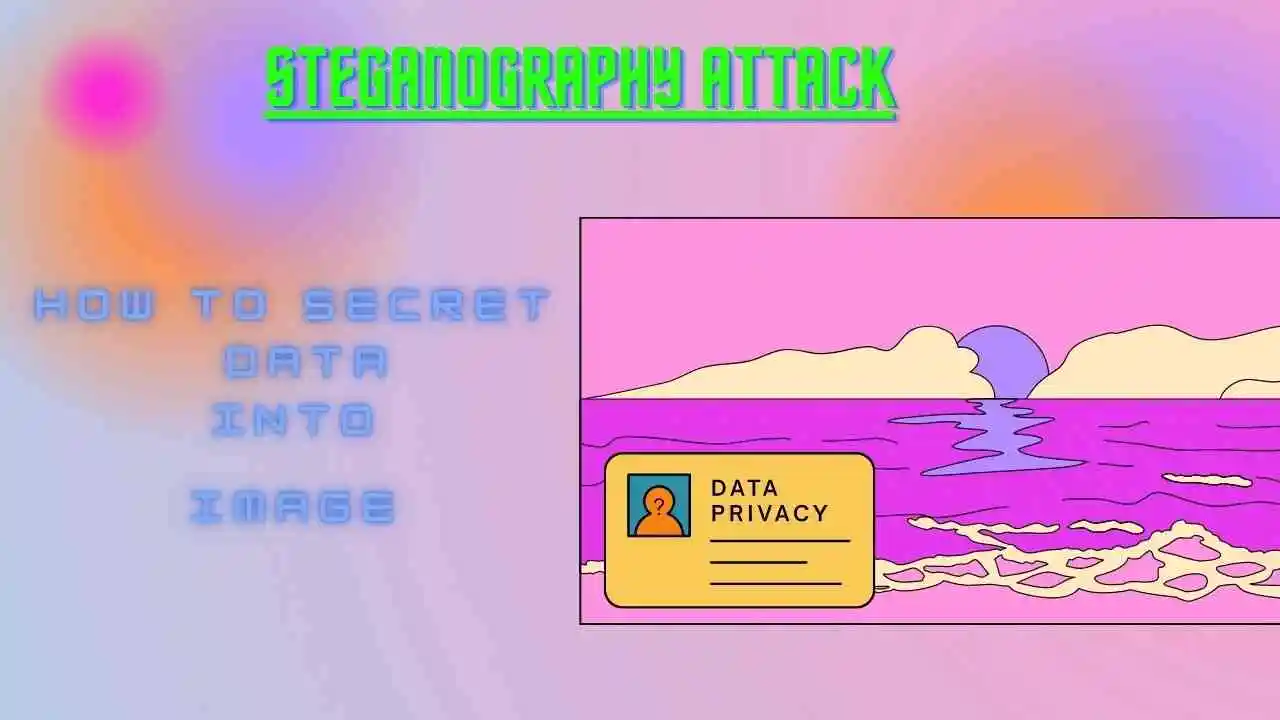In this blog, we will learn about the Steganography Attack and also see how to perform it. The main intention of this attack is to send a hidden message to the target system. So let’s get started with the blog.
Table of Contents
- Introduction
- Category of Steganography Attack
- Techniques for Steganography Attack
- Characteristics of Steganography Attack
- Practical for Steganography Attack
- Recent Articles on Computer Networks
- Recent Articles on Linux
Introduction
Steganography Attack is a method of hiding data or media to prevent detection. The word is a combination of the Greek words steganos, which means “covered” or “hidden,” and graph, which means “to write.” Consequently, “hidden writing.”
Steganography is the practice of hiding secret information within a seemingly innocuous carrier medium. In the context of ethical hacking, steganography can be used by security professionals to test the effectiveness of security measures in detecting and preventing covert communication channels.
Ethical hackers may use steganography to conceal malicious code or other sensitive data within a seemingly harmless image or audio file.
This can be used to evade detection by security tools that are only looking for specific types of malicious code and to bypass security measures that are designed to block certain types of communication.
Category of Steganography Attack
Steganography Attacks can be categorized into different types based on the methods used to hide information and the mediums used as carriers. Here are five common types of steganography:
Image Steganography:
This type of steganography involves hiding information within digital images. The hidden data is embedded by subtly modifying the pixel values or the least significant bits (LSBs) of the image. Image steganography techniques include Least Significant Bit (LSB) insertion, Spread Spectrum, and Transform Domain methods like Discrete Cosine Transform (DCT) or Discrete Wavelet Transform (DWT) techniques.
Audio Steganography:
In audio steganography, the hidden information is concealed within audio files, such as WAV, MP3, or MIDI files. Similar to image steganography, the data is embedded by altering specific features or properties of the audio signal that are less perceptible to human hearing. Audio steganography methods often rely on techniques like LSB manipulation, phase coding, echo hiding, or frequency domain manipulation.
Video Steganography:
Video steganography involves hiding data within digital video files. The hidden information can be embedded in the video frames or the audio component of the video file. Video steganography methods may utilize techniques like frame manipulation, motion vector manipulation, or modifying the video codec parameters.
Text Steganography:
Text steganography focuses on hiding information within text documents or messages. It can involve subtle modifications to the text content, such as altering character positions, and word choices, or using special encoding techniques. Text steganography methods can be further classified into techniques like linguistic steganography, format-based steganography, or whitespace manipulation.
Network Steganography:
Network steganography involves hiding data within network protocols or network traffic. This type of steganography is commonly used to bypass network security mechanisms and covertly transmit information. Network steganography techniques include techniques like protocol-based steganography, where hidden data is embedded within protocol headers or payload, or using techniques like tunneling or covert channels to conceal information within legitimate network communications.
These categories are not mutually exclusive, and there can be overlaps and variations in steganographic techniques. The choice of steganography type depends on the medium used for communication, the desired level of security, and the potential detection methods that might be encountered.
Techniques for Steganography Attack
Steganography techniques can vary in terms of how they conceal information within carrier data. Here are some common types of steganography techniques:
LSB (Least Significant Bit) Steganography:
LSB is one of the most basic and widely used techniques in steganography. It involves replacing the least significant bits of the carrier data (such as pixels in an image or audio samples) with the bits of the hidden message. Since the changes in the LSBs are typically imperceptible to human observers, this technique allows for the hiding of data without significantly altering the appearance or quality of the carrier data.
Spread Spectrum Steganography:
Spread Spectrum techniques distribute the hidden information across the carrier data using a modulation process. The hidden message is spread over a wider range of frequencies or time intervals, making it difficult to detect. The receiver knows the modulation pattern and can extract the hidden message by reversing the process.
Transform Domain Steganography:
Transform domain techniques apply mathematical transformations, such as Discrete Fourier Transform (DFT), Discrete Cosine Transform (DCT), or Discrete Wavelet Transform (DWT), to the carrier data. The hidden message is embedded in the transformed domain coefficients, which may be less perceptible to human observers. The receiver applies the inverse transform to extract the hidden information.
These are just some of the common steganography techniques, and there are numerous variations and hybrid methods that combine multiple techniques to enhance the security and robustness of hidden information.
Characteristics of Steganography Attack
Steganography techniques possess certain characteristics that contribute to their effectiveness and suitability for different scenarios. Here are some key characteristics of steganography techniques:
Imperceptibility:
One of the primary characteristics of steganography techniques is imperceptibility. The hidden information should be embedded in such a way that it is visually or audibly indistinguishable from the original carrier data. The changes made by the steganographic process should be subtle enough to avoid detection by human observers.
Capacity:
The capacity of a steganography technique refers to the amount of hidden information that can be effectively embedded within the carrier data. Different techniques have varying capacities, and some may provide higher data-hiding capacities than others. Techniques with larger capacities allow for hiding more extensive or complex messages.
Robustness:
Robustness refers to the ability of a steganography technique to withstand various modifications or attacks without losing hidden information. Robust techniques can handle common signal processing operations, such as compression, noise addition, or format conversion, without significant loss or corruption of the hidden message.
Security:
Security is a crucial characteristic of steganography techniques. It refers to the resistance against the detection or unauthorized extraction of hidden information. Secure techniques ensure that the hidden message remains concealed even when subjected to steganalysis attacks or known-plaintext attacks.
Complexity:
The complexity of a steganography technique determines the difficulty of detecting or breaking hidden information. Techniques with higher complexity may involve more sophisticated algorithms, encryption mechanisms, or advanced embedding strategies, making it more challenging for attackers to extract the hidden data without prior knowledge.
Embedding and Extraction Efficiency:
The efficiency of a steganography technique relates to the computational resources required for embedding and extracting the hidden information. Efficient techniques minimize the computational overhead, processing time, and memory usage, enabling faster and more practical embedding and extraction operations.
Detectability:
Detectability refers to the extent to which steganographic modifications can be identified or detected. Techniques that leave noticeable artifacts or statistical anomalies in the carrier data may be more prone to detection by steganalysis tools or trained analysts.
It’s important to note that the characteristics of steganography techniques may vary based on the specific algorithm, implementation, and application context. The choice of technique depends on the specific requirements, security considerations, and the medium used for hiding and transmitting the information.
Practical for Steganography Attack
A) Store the Data in the Images
The simple task is that you have to store the message in the image file. So let’s get started with the blog.
A) Installation of the tool
$ sudo apt-get install -y stegsnowB) Store the message in the text file.
$ stegsnow -C -m "This is the secret message" -p "pass" text.jpg output.txt
Compressed by 45.67%
Message exceeded available space by approximately inf%.
An extra 4 lines were added.So, what are we doing with the above command? Let’s see:
Here,
-m: Message for the secret text stored in the file.
-p: Password for the file.
So above command stores the secret message in the “output.txt” file.
B) Read the Encrypted data from the Image
Let’s see read the “output.txt” file with the cat command.
$cat output.txt
There is no data in the file according to the cat command. So here comes the role of the stegsnow command to read the file.
$ stegsnow -C -p "pass" output.txt
This is the secret message$
So, here you can see the data which is stored in the “output.txt” file.Now you can share the file with anybody it is protected by the password.
Steganography Attack is a method of hiding data or media to prevent detection. The word is a combination of the Greek words steganos, which means “covered” or “hidden,” and graph, which means “to write.” Consequently, “hidden writing.”
Steganography is the practice of hiding secret information within a seemingly innocuous carrier medium. In the context of ethical hacking, steganography can be used by security professionals to test the effectiveness of security measures in detecting and preventing covert communication channels.
Ethical hackers may use steganography to conceal malicious code or other sensitive data within a seemingly harmless image or audio file.
Recent Articles on Computer Networks
- Introduction to Computer Networking | What is Computer Network
- What are Topology & Types of Topology in Computer Network
- What is FootPrinting in Cyber Security and its Types, Purpose
- Introduction to Cloud Computing | What is Cloud Computing
- Distributed Shared Memory and its advantages and Disadvantages
- What is VPN? How doe VPN Work? What VPN should I use?
- What is an Internet and How the Internet Works
- What is a Website and How Does a Website or web work?
- Introduction to Virus and different types of Viruses in Computer
- What is TCP and its Types and What is TCP three-way Handshake
- What is UDP Protocol? How does it work and what are its advantages?
- What is an IP and its Functions, What is IPv4 and IPv6 Address
- What is MAC Address and its Types and Difference MAC vs IP
- What is ARP and its Types? How Does it Work and ARP Format
- Sessions and Cookies and the Difference Between Them
- What is ICMP Protocol and its Message Format?
- What is Big Data? Characteristics and Types of Big Data
- Disciplines of CyberSecurity | What are the goals of CyberSecurity?
- What is Firewall, Features, Types and How does the Firewall Work?
- Network Scanning, Types, and Stealth Scan in Computer Network
- Cryptography and its Types in Ethical Hacking
- Tor Browser and How does it Work | Onion Router Tutorial
- Proxy Server, Advantages, Difference between Proxy Server & VPN
Recent Articles on Linux
- What is Linux Operating System | Introduction to Linux
- Directory in Linux Define | Linux Directory & its Commands
- Explain the chmod command in Linux | Linux chmod command
- Linux User Management || User Management in Linux
- Linux Computer Network Advanced Command | Network Command
- Redirection in Linux I/O| Linux I/O Redirection
- CronTab and Job Scheduling in Linux | Make CronTab Project
- Linux Firewall Unlock Rules with Firewall-cmd Tutorial
- netstat command in Linux | Linux netstat command
- SSH Command Full Guide with Practical | Linux SSH Service




